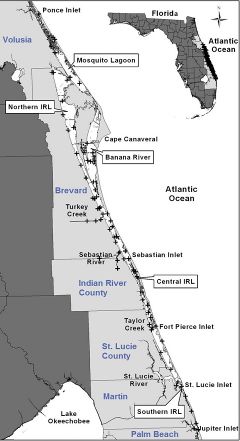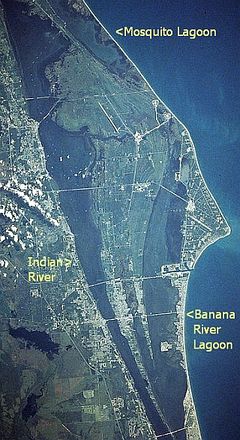Category:National Estuary
The United States Environmental Protection Agency has designated the Indian River Lagoon as an Estuary of National Significance in it's National Estuary Program.
About the IRL National Estuary
The Indian River Lagoon National Estuary is a 156-mile long brackish lagoon estuary, that spans 40% of Florida's East Coast. The estuary's 3 main bodies of water are the Mosquito, Banana River and Indian River lagoons.[1]
Despite the name, the Indian River is actually a lagoon with no directional current flow. It's brackish water body is a confluence of 4 saltwater Atlantic Ocean inlets, 5 freshwater rivers and numerous feeder creeks. Within it's boundaries are an Air Force Base, a National Space Center, a National Seashore, two National Wildlife Refuges, and several wildlife sanctuaries. It's vast waters provide an outdoor recreational playground for boaters, fishers, birders, campers, hikers, bikers and day trippers alike.
It's temperate location and varied habitats make the Indian River Estuary one of the most bio-diverse habitats in North America. The estuary's mangrove shorelines, spoil islands, oyster bars, saltwater marshes, and seagrass flats provide habitat for terrestrial and aquatic species found in both freshwater and saltwater ecosystems. The estuary is home to over 4000 plant and animal species, some threatened or endangered.
Impact
The Indian River Lagoon National Estuary spreads across Volusia, Brevard, Indian River, St. Lucie, Martin, and Palm Beach counties with a rapidly growing population of 1.5 million residents. Waterfront residents enjoy a panoramic view, a parade of watercraft, unique wildlife sightings, and private boat docks providing instant water access.
Human impact from outdated sewer utilities, septic tank drain fields, stormwater run-off, yard fertilizer, and excessive wetland development has adversely affected the estuary's health. The result of this impact can be seen in recent green algae outbreaks, fueled by an excess of phosphorous and nitrogen, which created an oxygen loss in the water, that caused widespread fish kills across several Florida counties. This green algae outbreak rendered parts of the estuary unusable, killed many plants and animals, turned waterfront living to an undesirable neighborhood, created respiratory health problems for residents, and completely devastated the ecotourism industry.
A healthy estuary is a vital economic factor in the local community. It provides direct income for resident's who work both on and off the water. Commercial fishing, ecotourism, outdoor equipment retail, watercraft sales/service, and marina industries all directly depend on the estuary for income. The success of the above industries trickles income down to the local tourism, hospitality, transportation and real estate industries. A 2016 impact study estimated the total economic value of the Indian River Lagoon Estuary to be $7,640,311,564 per year.[2]
Preservation
We can successfully restore and preserve the IRL for future generations to enjoy.
Pages in category "National Estuary"
The following 5 pages are in this category, out of 5 total.

